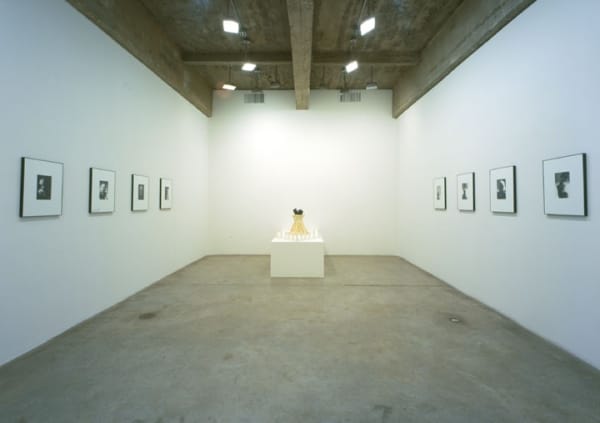Tanya Bonakdar Gallery is very pleased to announce the opening on January 20 of the gallery’s eighth solo exhibition with Peggy Preheim, ‘Three Sheets to the Wind.’ In addition to a selection of new drawings and photographic works, the exhibition will feature the largest and most compelling presentation of Preheim’s sculpture to date. Preheim’s exquisitely surreal figurative compositions of unfired white clay and found objects are presented on freestanding pedestals or shelves, often within glass vitrines, or large glass bell domes. Constructing enigmatic narratives and referencing ancient myths, Preheim’s practice touches upon the most intimate yet universal images and themes, resonating with complex psychologically depth and meaning.
Aside from referencing the state of intoxication, the title suggests a narrative of movement, or a journey. As one looks at the development of Peggy Preheim’s practice since the early 1990’s, it becomes clear that the reference is to a personal odyssey that has resulted in a return to sculpture as the focal mode of expression. Literally, the work featured in 'Three Sheets to the Wind', all dated from 1994 to 2004 and comprised of elements made or collected over the past decade, juxtaposed and arranged into new compositions. Figures made from white clay wear antique doll dresses, set upon stemware to form delicately strange new ‘combines,’ or ‘ready-mades.’ In 'Bride,' an antique glass urinal is dressed in a pink doll's dress, with a handle protruding through an opening in the back. Duchamp, Hans Bellmer and Joseph Cornell resonate here, although Preheim's work is less about such art historical references, as it is a personal exploration of sculpture and storytelling.
The theme of the journey is further referenced in works related to Homer’s ‘Odyssey’, a ten-years saga that parallels the artist’s ten-years process in making the work for this show. In 'Between the Sheets', Preheim constructs a quintessential multi-figure compositions of clay forms set within a two-tier glass box. Delicate figures represent the male and female sexes, and an androgynous Penelope nurses an imaginary pre-natal infant awaiting the return of Ulysses. As in all of Preheim’s sculpture, the smoothness of the white clay form bears the perfect complexion of memories, or dreams, uncannily detailed, yet unnaturally void of detail. Preheim's work is filled with such contradictions, as fragile figures are wrapped in bandages and set beneath glass; a sheltered tenderness undermined by perversity. The use of antique dolls and doll dresses suggest their own mysteries and enigmatic contradictions. Despite the consistent use of child-like, or images of infants, the connotation is not youth, or newness. Rather the bone white surfaces and aged suggest the age and timelessness of artifacts - an impression reinforced by their placement within glass domes. In 'Blink of an Eye', glassy ‘sleeping’ dolls’ eyes poke out through the white clay skin of two baby girl busts, like some ancient life form reconstructed for a natural history display from the smallest fossil fragment.
The void space plays a significant and recurring role in the work, and echoes recent drawings that featured white fields, untouched by graphite within exquisitely rendered figures. Several works featuring small antique doll outfits sit upon stemware placed within glass domes. The dresses appear suspended, yet hold their shape, as if worn by an invisible figure, or one that has disappeared so recently that gravity has yet to collapse the dress to the ground. One such work is titled ‘Eurydice,’ a reference to the ancient myth of Orpheus. Eurydice disappeared when Orpheus turned to make sure that his young love was following him out of the underworld.
Peggy Preheim lives and works in New York. Recent group exhibitions include, Symbolic Space, Hudson Valley Center for Contemporary Art. The Draftsman's Colors: 14 New Acquisitions from Johns to Chong, The Whitney Museum of American Art, New York; Blurry Lines, John Michael Kohler Art Center, Sheboygan; Drawings on the Figure: Works on Paper from the Manilow Collection, Museum of Contemporary Art, Chicago.



